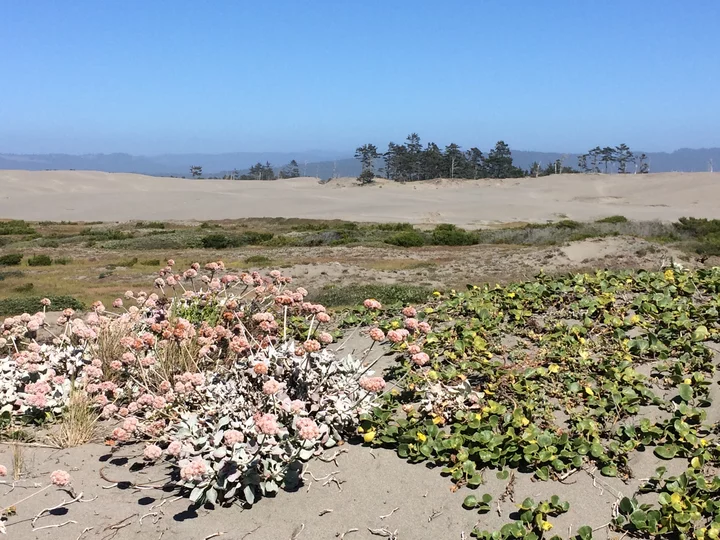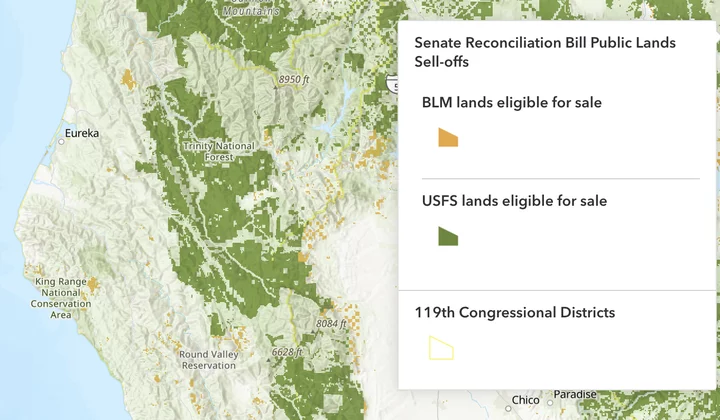The Ma-le’l Dunes is just one of several locations in Humboldt County “eligible for sale” under the public lands sell-off. | Photo: Jen Kalt - Humboldt Waterkeeper
###
UPDATE: Sen. Mike Lee introduced a revised version of the bill — linked here — shortly after our story was published. While the updated version does not include public lands managed by the U.S. Forest Service, it still calls for the mandatory sale of up to 0.5 percent, estimated at 1.2 million acres, of Bureau of Land Management lands located within five miles of a “population center.”
###
Original post: For a couple of weeks now, social media feeds have been clogged with news of a Republican-sponsored plan to sell off millions of acres of public lands across Western states, including protected areas along the North Coast, a plan that, for the moment at least, is dead.
The controversial proposal, introduced by Utah Sen. Mike Lee, sought to mandate the sale of more than 3,200 square miles of federal lands managed by the Bureau of Land Management and U.S. Forest Service to accommodate new housing and infrastructure developments. The mandate was ruled out of the GOP’s tax and spending bill on Monday after the Senate parliamentarian determined it would violate the chamber’s rules. Lee has vowed to revise and reintroduce the bill.
The plan has sparked concern among local conservationists who fear the mandate would result in the forced sale of public lands here in Humboldt, including the North and South Spits of Humboldt Bay, a piece of the Ma-le’l Dunes, portions of the King Range and large swaths of the Six Rivers, Klamath and Trinity National Forests, among others.
A map showing public lands eligible for sale in Humboldt. To zoom in, go here.
An interactive map published by the Wilderness Society indicates that over 250 million acres of public lands — including 16 million acres in California — “are eligible for sale” under the current version of the bill.
In a recent interview with the Outpost, Rep. Jared Huffman emphasized the distinction between eligible and mandatory sales. “I think it’s important to distinguish lands that would be eligible and lands where sales would be mandated,” he said. “My understanding in reading Sen. Lee’s bill is that there would be a requirement that at least three million acres would have to be offered up for sale, but they could go up to the full amount of 250 million eligible acres. That is theoretically possible in the way this bill is written.”
Still, there’s no telling where those sales are going to happen, Huffman said. “The mandatory sale of those three million acres … would be somewhere on this map depicting 250 million acres of eligible land, but we don’t know where.”
Lee took to social media on Monday night to announce his intent to “SIGNIFICANTLY REDUCE the amount of BLM land in the bill,” noting that “only land WITHIN 5 MILES of population centers” would be eligible for sale. He added that he would “REMOVE ALL Forest Service” land from the plan.
So, if the bill were amended to exclude Forest Service land and focus only on public lands near population centers, what would that mean for those protected areas along the Samoa Peninsula?
Reached for additional comment, Tom Wheeler, executive director of the Environmental Protection Information Center (EPIC), emphasized that Lee’s amended proposal still poses a “credible threat.”
“The North Spit, for example, is adjacent to existing communities and its coastal property in California. It’s not beyond the bounds of reasonable imagination that someone would want to see some development there,” Wheeler said. “Could the Ma-le’l Dunes be turned into a housing development? I don’t know. There would be obstacles — including the California Coastal Commission, Humboldt County’s land use ordinances and local opposition — but it could be sold to somebody who has a couple of million dollars and wants to try to do another Sea Ranch.”
However, Huffman said he wasn’t so sure that there would be obstacles to a federal public lands sell-off, noting that the Trump Administration has been “chopping away” at the National Environmental Policy Act (NEPA) and other federal conservation laws. “If some of these lands ended up making the cut and were put up for sale, I don’t know that there would be a lot of public process and safeguards to control what happens,” he said.
Huffman noted that the proposal has lost traction among Western Republicans facing pressure from hunters and fishermen.
“This is not something the American people want to see,” Huffman continued. “It’s not something that communities that care about these public lands want to see, certainly not the people who care about recreation. The hunters and fishermen? They don’t want to see this. This is coming from a few ideological extremists in Congress who are taking this vulture capitalist approach to our natural resources, where you just try to monetize, liquidate and create fast cash.”
While the public lands sell-off no longer presents an immediate threat, Huffman warned that the “zombie” bill “won’t be fully dead until Democrats have a majority and can enact some permanent protections for some of these places.”
“In the meantime, I think we have to sleep with one eye open,” he said.


CLICK TO MANAGE